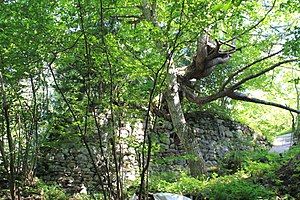Ödenfest castle ruins
| Ödenfest castle ruins | ||
|---|---|---|
|
Ödenfest castle ruins |
||
| Alternative name (s): | Mal (l) enthein, Rau (c) henfest, Malta | |
| Creation time : | 11th century | |
| Castle type : | Hilltop castle | |
| Conservation status: | Ruin, remains of the wall | |
| Standing position : | Ministeriale | |
| Place: | Malta | |
| Geographical location | 46 ° 57 '26.4 " N , 13 ° 30' 46.9" E | |
| Height: | 1000 m above sea level NN | |
|
|
||
The Ödenfest castle ruins , also known as Mal (l) enthein , Rau (c) henfest or Malta for short , are the ruins of a medieval hilltop castle at around 1000 m above sea level. NN above the village of Malta in Carinthia , which was built in the 11th century, but was abandoned to decay in the 14th century.
history
While there is evidence of a documentary mention of the place Malta as early as the 10th century (957/93 as loco Malontina ), the castle was probably not built until the 11th century. The first written mention comes from the time between 1075 and 1090. It was owned by a nobleman named Heimo, a ministerial of the diocese of Bressanone . In the 12th century it came to a branch line of the Counts of Heunburg , who called themselves "Malentheiner" after the place. A Walther de Malantin is documented as the first verifiable bearer of this name for 1129/30. Count Wilhelm III. von Heunburg called himself comes de Malentin in 1226 and others of his sex called themselves "von Malta".
The castle may have been destroyed when Count Ulrich III. von Heunburg († 1308) together with the Archbishop of Salzburg revolted against the Meinhardiner and Duke Albrecht of Austria . In any case, the complex began to deteriorate in the 14th century after it no longer served as a mansion.
Since the river, town and castle had the same name, people named themselves after the town were found again and again in the following period. Including Hans Malteiner in 1411, Jörg Maleteyner in 1465, Georg Malentheiner in 1496 and 1531 and Jakob Malentheiner in 1577. From around 1400 they no longer sat in the castle, but worked in various parts of Upper Carinthia as carers , civil servants or trades , until the Carinthian line of the male line died out in 1768.
In 1622 a Georg von Mallenthein appears, whose family sat in the 16th century at Prießenegg Castle in Kühweg near Hermagor, which was then also called Malenthein Castle .
Building description
The listed remains of the castle are located above the village at about 1000 meters above sea level on a rocky outcrop. All that remains of the castle is a wall about eight meters long and four to five meters high, as well as a few lower remains of the inner walls. The two meter thick wall is the southeastern part of the castle's ring wall , which enclosed an elongated, seven-sided area.
See also
literature
- Dehio Carinthia 2001 . Verlag Anton Schroll & Co., Vienna 2001, ISBN 3-7031-0712-X , p. 493 f.
- Hermann Wiessner, Margareta Vyoral-Tschapka: Castles and palaces in Carinthia. Volume 3. Hermagor, Spittal / Drau, Villach . Birken-Verlag, Vienna 1986, 2nd edition, without ISBN, p. 81.

